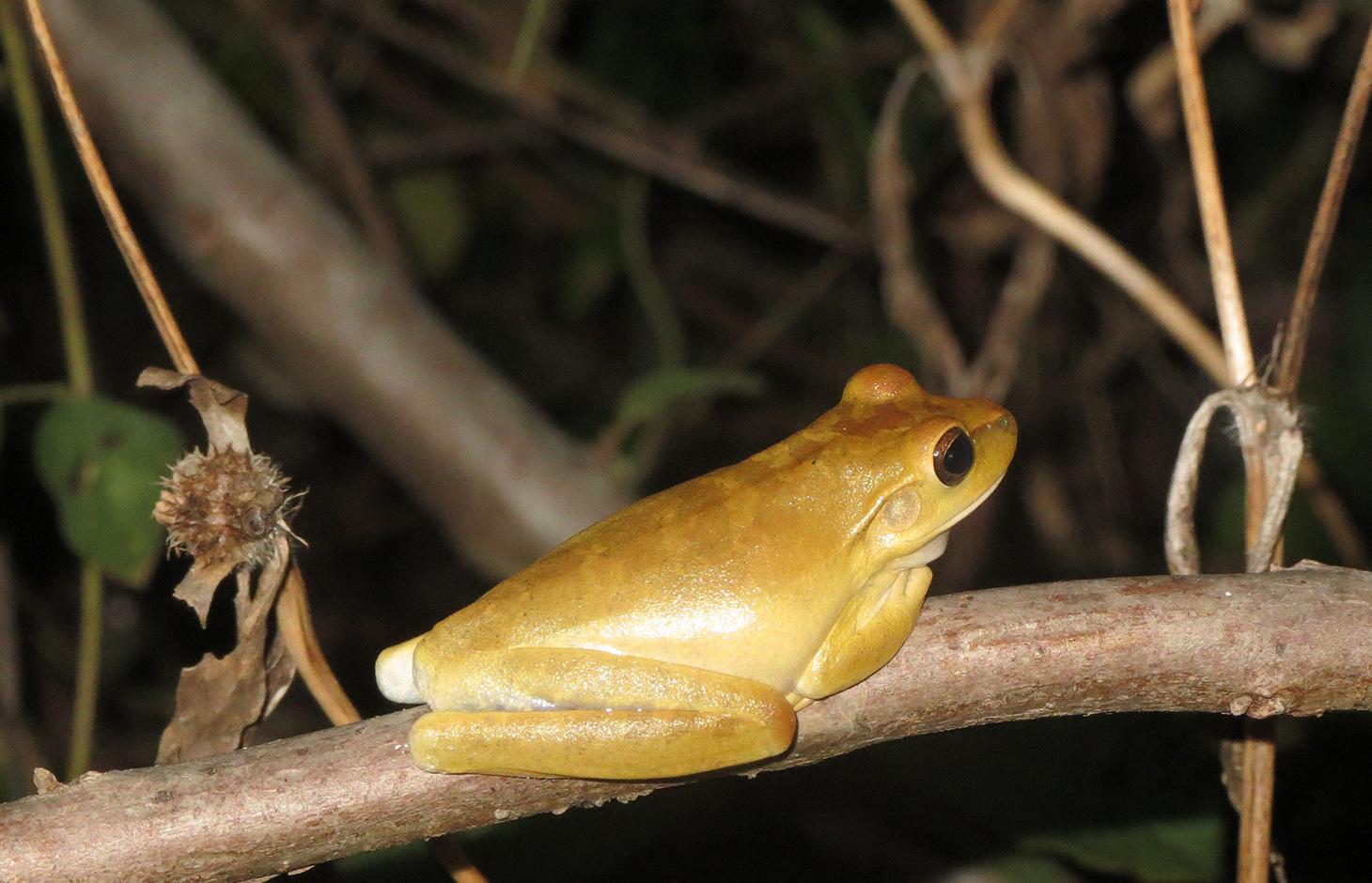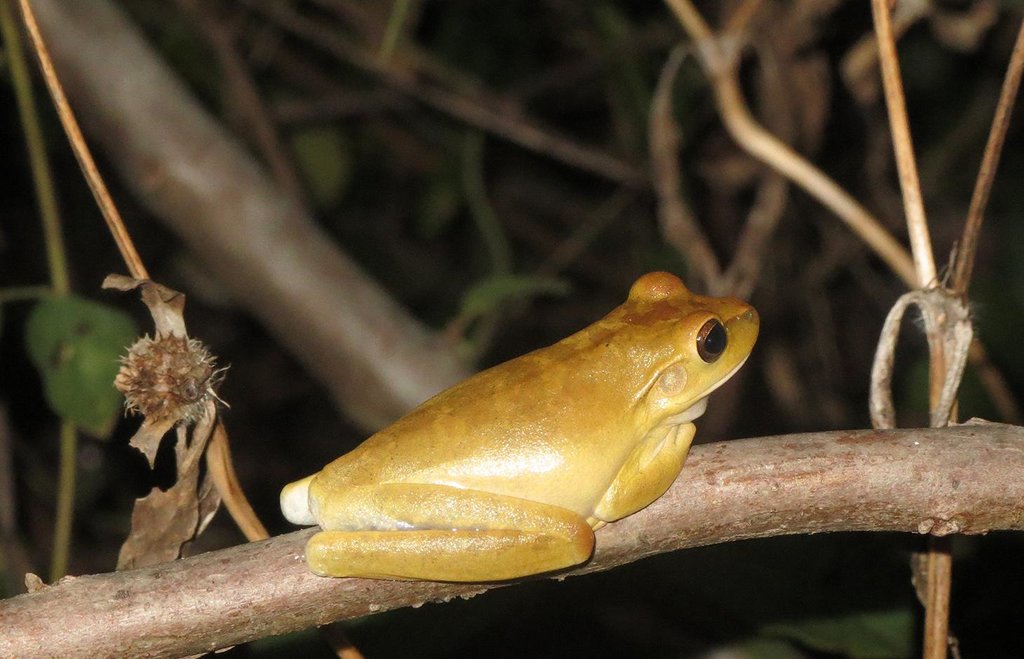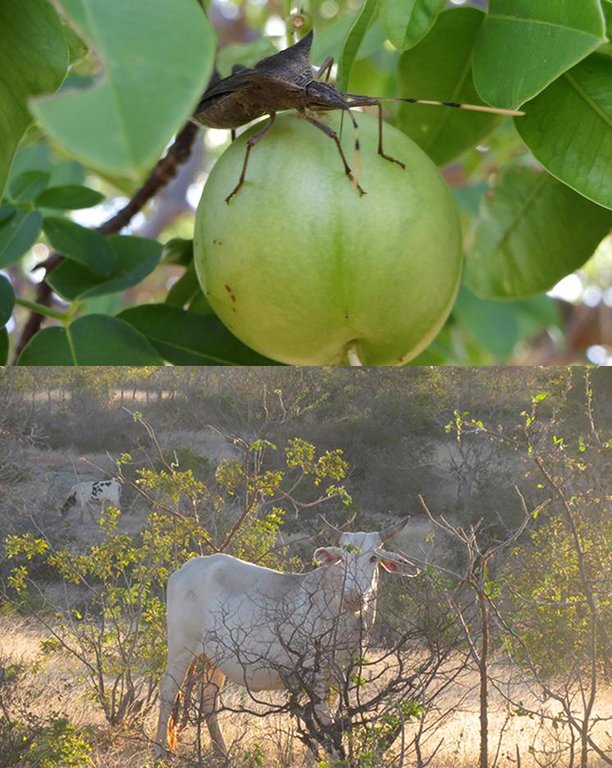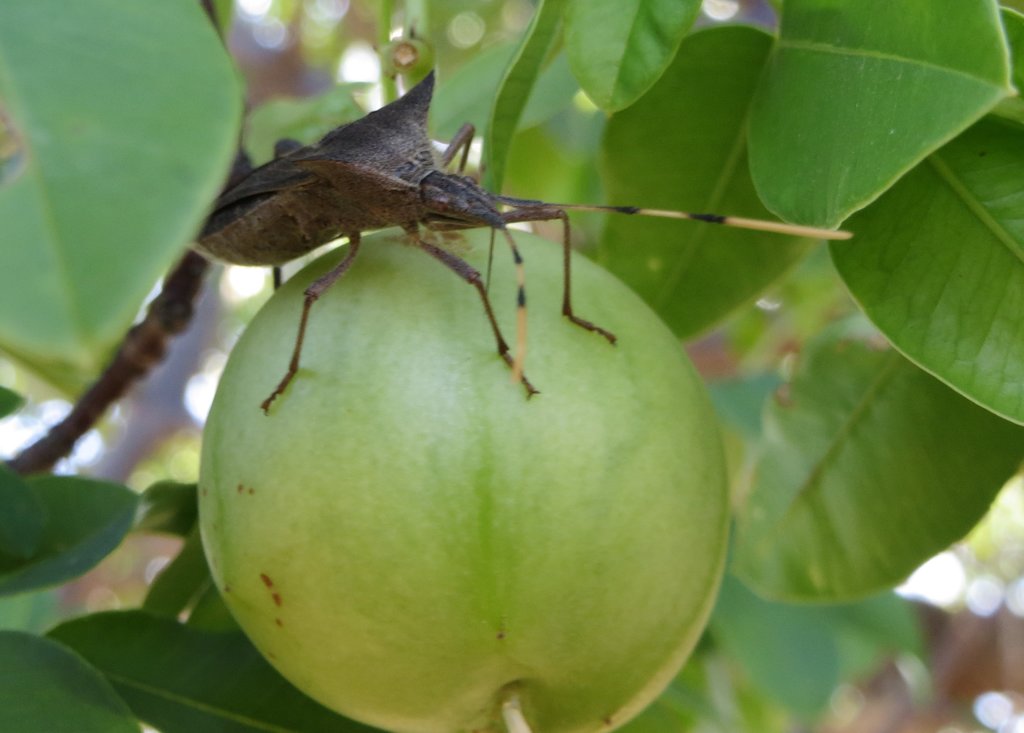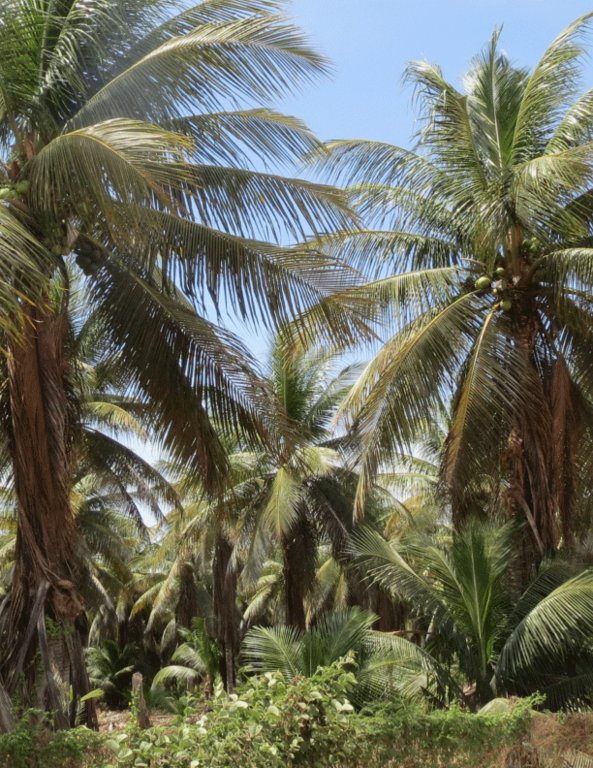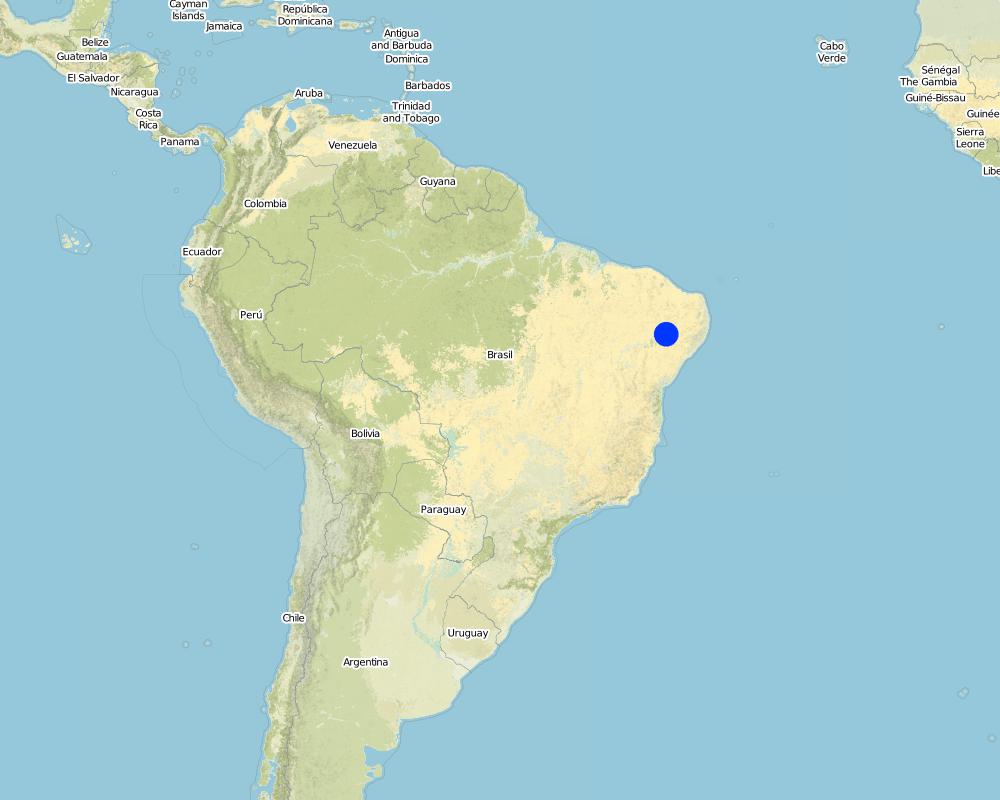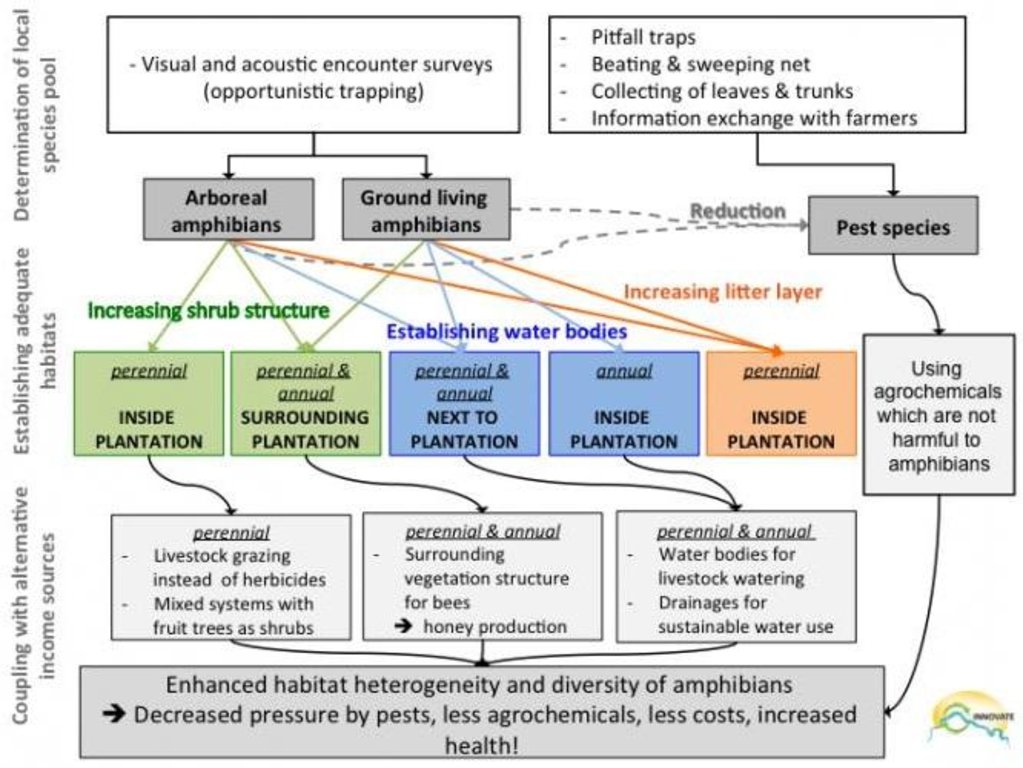Biological pest control through promoting habitats for native fauna [Brazil]
- Creation:
- Update:
- Compiler: Marianna Siegmund-Schultze
- Editor: –
- Reviewers: Alexandra Gavilano, Fabian Ottiger, David Streiff
Controle biológico de pragas pela fauna nativa: manter ou restabelecer habitats respectivos (Portuguese)
technologies_1293 - Brazil
View sections
Expand all Collapse all1. General information
1.2 Contact details of resource persons and institutions involved in the assessment and documentation of the Technology
SLM specialist:
Biologist:
Ernst Raffale
Senckenberg Natural History Collections Dresden
Germany
SLM specialist:
Hagel Heinrich
Universit of Hohenheim
Germany
Name of project which facilitated the documentation/ evaluation of the Technology (if relevant)
Book project: Making sense of research for sustainable land management (GLUES)Name of project which facilitated the documentation/ evaluation of the Technology (if relevant)
Interplay among multiple uses of water reservoirs via innovative coupling of substance cycles in aquatic and terrestrial ecosystems (INNOVATE / GLUES)Name of the institution(s) which facilitated the documentation/ evaluation of the Technology (if relevant)
Universität Hohenheim - GermanyName of the institution(s) which facilitated the documentation/ evaluation of the Technology (if relevant)
Senckenberg Natural History Collections Dresden - GermanyName of the institution(s) which facilitated the documentation/ evaluation of the Technology (if relevant)
Technische Universität Berlin (Technische Universität Berlin) - GermanyName of the institution(s) which facilitated the documentation/ evaluation of the Technology (if relevant)
Leibniz-Institut für Gewässerökologie und Binnenfischerei (IGB) - GermanyName of the institution(s) which facilitated the documentation/ evaluation of the Technology (if relevant)
Potsdam-Institut für Klimaforschung (PIK) - Germany1.3 Conditions regarding the use of data documented through WOCAT
The compiler and key resource person(s) accept the conditions regarding the use of data documented through WOCAT:
Yes
2. Description of the SLM Technology
2.1 Short description of the Technology
Definition of the Technology:
Reducing the use of common agrochemicals by supporting preferred habitats of biological pest control agents like amphibians and by using alternative self-made organic pesticides.
2.2 Detailed description of the Technology
Description:
Irrigated crops attract various pest species. Farmers usually address crop pest and disease problems through the use of agrochemicals. Especially bees, birds, and amphibians, which fulfil important functions in agroecosystems, are affected by high use of agrochemicals. The combination of inappropriate irrigation practices, incorrect application rates of agrochemicals, and low producer prices often lead, however, to poor income from smallholder irrigated agriculture and to further problems such as poor health, loss of biodiversity, and soil and water contamination. Amphibians are themselves proven biological pest control agents of arthropod pest species (predators of e.g. larvae of butterflies, beetles, termites, bugs and others) and the incorrect use of agrochemicals, as well as the removal of vegetation along field margins hampers this useful function. The technology described here aims to support and utilise the potential of amphibians (such as frogs and toads) as biocontrol agents –as an alternative to agrochemicals in crops.
Purpose of the Technology: Establishing habitats for amphibians is crucial in order to increase and secure their numbers: for example encouraging shrubby vegetation next to water bodies for arboreal frogs, and installing additional water ponds inside and around plantations for ground-living frogs. First, the local species pool of amphibians needs to be determined by visual and acoustic observations. Amphibian species do not need to be determined precisely, but it is important to detect whether they are arboreal and/or ground-living amphibians, as these two groups have different roles as biocontrol agents. Pests that feed on the main cultivated species should be characterized by (a) collecting plant material to determine the type and quantity of pests and (b) by comparing observations with neighbouring farmers and extension agents. Pest species can be determined also by installing traps and using nets. Inspection should be done at least every 15 days to once a month during the whole rainy season to detect possible mass reproduction of arthropods after rainfall events. Once amphibians and pest species are detected, decisions on management strategies can be made. Such a strategy is to create habitats for amphibians with additional sources of income, e.g. by planting pomegranate or guavas as shrubby vegetation structure for arboreal frogs. If pest species can't be reduced solely by amphibian species, the use of agrochemicals has to be reconsidered. Preference shall be given to chemicals which do not harm amphibians. Organic, self-made pesticides based on the extract of manioc roots (manipoera) seem promising. Twenty litres of manipoera, the bark of manicoba tree (Manihot pseudoglaziovii), a cup of American wormseed (Dysphania ambrosioides), a cup of yellow tagetes (Tagetes sp.), a cup of malagueta pepper (Capsicum sp.), garlic and a little bit of bleach have to be chopped, mixed and fermented for 10 days. Application of the final product (25 ml of organic pesticide diluted in 20 l of water) should be done every 8 to 15 days depending on crop species.
Natural / human environment: Increasing habitat heterogeneity stimulates the diversity of amphibians and so a greater number of pest types will be controlled. Combined control by safeguarding natural amphibian habitats and application of organic pesticides is an innovative alternative to the overuse of toxic agrochemicals.
2.3 Photos of the Technology
2.5 Country/ region/ locations where the Technology has been applied and which are covered by this assessment
Country:
Brazil
Region/ State/ Province:
Floresta, Itacuruba, Petrolandia
Further specification of location:
Brazil, Pernambuco
Specify the spread of the Technology:
- evenly spread over an area
If precise area is not known, indicate approximate area covered:
- 0.1-1 km2
Comments:
The technology was carried out both in a forest system as well as in agricultural areas. An incrasing SLM Technology area is linked to an increasing sampling number.
Map
×2.6 Date of implementation
If precise year is not known, indicate approximate date:
- more than 50 years ago (traditional)
2.7 Introduction of the Technology
Specify how the Technology was introduced:
- during experiments/ research
3. Classification of the SLM Technology
3.2 Current land use type(s) where the Technology is applied
Land use mixed within the same land unit:
Yes
Specify mixed land use (crops/ grazing/ trees):
- Agro-silvopastoralism

Cropland
- Annual cropping
- Perennial (non-woody) cropping
- Tree and shrub cropping
Annual cropping - Specify crops:
- legumes and pulses - beans
- medicinal/ aromatic/ pesticidal plants and herbs
- root/tuber crops - cassava
- vegetables - melon, pumpkin, squash or gourd
- vegetables - other
- vegetables - root vegetables (carrots, onions, beet, other)
Perennial (non-woody) cropping - Specify crops:
- banana/plantain/abaca
Tree and shrub cropping - Specify crops:
- coconut (fruit, coir, leaves, etc.)
- grapes
- mango, mangosteen, guava
Number of growing seasons per year:
- 1
Specify:
Longest growing period from month to month: January to May

Grazing land
Extensive grazing:
- Nomadism
- Semi-nomadic pastoralism
- Ranching
Intensive grazing/ fodder production:
- Cut-and-carry/ zero grazing
- Improved pastures
Animal type:
- goats
- sheep
- cattle

Forest/ woodlands
- (Semi-)natural forests/ woodlands
- Tree plantation, afforestation
(Semi-)natural forests/ woodlands: Specify management type:
- Selective felling
- Clear felling
- Shifting cultivation
Products and services:
- Timber
- Fuelwood
- Fruits and nuts
- Other forest products
- Grazing/ browsing
- Nature conservation/ protection
Comments:
Major land use problems (compiler’s opinion): Intensive livestock grazing pressure, agriculture and logging of native vegetation are the driving factors behind loss of the Caatinga dry forest. The high use of agrochemicals additionally pollutes soils and watersheds, and probably also decreases local biodiversity. Droughts seem to occur more frequently and these decrease water and food availability for livestock, as well as affecting the local fauna.
Example for establishment of technology within study region: In the irrigation schemes of Petrolândia, Pernambuco, Brazil, the most important arthropod pest species in banana plantation was a weevil (Curculionidae, Coleoptera). The weevil (so called “moleque da bananeira”) attacked the roots of the banana plants, in consequence the plant tumbled down and was lost. As the weevil stays during the day in the ground and only starts moving during the night, it is difficult to combat this pest species by agrochemicals. With an increase of small water ponds with a shore vegetation structure (for example at 2 corners of the plantation) the abundance of ground-living amphibians increases and so the presence of amphibians in the banana plantation which feed on the weevil during the night.
Major land use problems (land users’ perception): Droughts and consequently problems of feeding livestock on natural vegetation (lack of fodder and grazing grounds), deforestation, extensive and inappropriate use of agrochemicals, low producer prices.
Nomadism: goat, sheep, cattle
Semi-nomadism / pastoralism: goat, sheep, cattle
Ranching: goat, sheep, cattle
Cut-and-carry/ zero grazing: goat, sheep, cattle
Improved pasture: goat, sheep, cattle
Mixed: (eg agro-pastoralism, silvo-pastoralism): goat, sheep, cattle
Selective felling of (semi-) natural forests: Yes
Clear felling of (semi-)natural forests: Yes
Shifting cultivation: Yes
Plantation forestry: Yes
Forest products and services: timber, fuelwood, fruits and nuts, grazing / browsing, other forest products / uses (honey, medical, etc.), nature conservation / protection
Livestock is grazing on crop residues
3.4 Water supply
Water supply for the land on which the Technology is applied:
- mixed rainfed-irrigated
3.5 SLM group to which the Technology belongs
- integrated pest and disease management (incl. organic agriculture)
- Biological pest control
3.6 SLM measures comprising the Technology

agronomic measures
- A1: Vegetation/ soil cover

vegetative measures
- V1: Tree and shrub cover
- V2: Grasses and perennial herbaceous plants

structural measures
- S3: Graded ditches, channels, waterways
- S5: Dams, pans, ponds

management measures
- M2: Change of management/ intensity level
Comments:
Main measures: agronomic measures, vegetative measures, structural measures, management measures
Type of agronomic measures: retaining more vegetation cover
3.7 Main types of land degradation addressed by the Technology

chemical soil deterioration
- Cn: fertility decline and reduced organic matter content (not caused by erosion)

biological degradation
- Bc: reduction of vegetation cover
- Bh: loss of habitats
- Bs: quality and species composition/ diversity decline
- Bp: increase of pests/ diseases, loss of predators

water degradation
- Hs: change in quantity of surface water
Comments:
Main type of degradation addressed: Bc: reduction of vegetation cover, Bh: loss of habitats, Bs: quality and species composition /diversity decline, Bp: increase of pests / diseases, loss of predators, Hs: change in quantity of surface water
Secondary types of degradation addressed: Cn: fertility decline and reduced organic matter content
Main causes of degradation:
Direct causes - Human induced: crop management (annual, perennial, tree/shrub) (high use of agrochemicals, degradation of natural habitats), deforestation / removal of natural vegetation (incl. forest fires) (high logging and grazing intensity, no forest area without grazing!), overgrazing (high logging and grazing intensity, no forest area without grazing!)
Direct causes - Natural: change in temperature (droughts become more frequently), change of seasonal rainfall (droughts become more frequently), heavy / extreme rainfall (intensity/amounts) (less rainfall intensity), droughts (droughts become more frequently)
Secondary causes of degradation: urbanisation and infrastructure development (extending farmlands), population pressure (extending farmlands), poverty / wealth (farmers need to use natural resources as livestock fodder), education, access to knowledge and support services (less environmental awareness)
3.8 Prevention, reduction, or restoration of land degradation
Specify the goal of the Technology with regard to land degradation:
- prevent land degradation
- reduce land degradation
Comments:
Main goals: prevention of land degradation, mitigation / reduction of land degradation
Secondary goals: rehabilitation / reclamation of denuded land
4. Technical specifications, implementation activities, inputs, and costs
4.1 Technical drawing of the Technology
Technical specifications (related to technical drawing):
Vegetation structures surrounding plantations beside waterbodies guarantee the occurrence of arboreal and ground-living amphibians. Arboreal frogs prefer shrubby vegetation. Since mowing or application of herbicides often eliminates shrubs, moderate livestock grazing might be a better option. The additional water bodies outside the plantation can thereby be used for livestock watering, as long as the surrounding vegetation structure is not eliminated through grazing. Fruit trees such as Guava or Pomegranate as shrub structure provide an additional source of income. To ensure the presence of ground-living frogs, smaller water bodies must be promoted within the plantation. Here puddles from leaky irrigation systems seem to be sufficient already.
Only agrochemicals and organic pesticides that are harmless to amphibians should be used as additional chemical pest control.
Date: 2016
Technical knowledge required for field staff / advisors: moderate (kowledge of habitat preference of important species and management issues)
Technical knowledge required for land users: low (kowledge of habitat preference of important species and management issues)
Main technical functions: increase in nutrient availability (supply, recycling,…), increase of biomass (quantity), promotion of vegetation species and varieties (quality, eg palatable fodder)
Secondary technical functions: control of dispersed runoff: retain / trap, control of dispersed runoff: impede / retard, control of concentrated runoff: retain / trap, control of concentrated runoff: impede / retard, control of concentrated runoff: drain / divert, increase of surface roughness, improvement of surface structure (crusting, sealing), improvement of topsoil structure (compaction), stabilisation of soil (eg by tree roots against land slides), increase in organic matter
Retaining more vegetation cover
Material/ species: herbs in planation of coconut, banana, guave, pomegranat etc.
Quantity/ density: dense
Change of land use practices / intensity level: less grazing in forest areas, less grazing at water ponds (fencing of a certain part of the pond), less cutting of shrubs and herbs in crop plantations (near to natural cutting by livestock)
Author:
M. Guschal & L. Steinmetz
4.3 Establishment activities
| Activity | Timing (season) | |
|---|---|---|
| 1. | Installing of additional small and large water bodies: a. large ponds outside the plantation (~100 m²/pond, ~ 4 ponds/plantation, one working day per pond) b. smaller ponds for ground-living frogs inside the plantation (one working day/ 5 ha). c. drainages can be installed instead of ponds outside the plantation for sustainable water use (machine rent) | |
| 2. | Large ponds outside the plantation (~100 m²/ponds, ~4 ponds/plantation, one working day per pond) | |
| 3. | Smaller ponds for ground-living frogs inside the plantation (one working day/ 5 ha) | |
| 4. | Drainages can be installed instead of ponds outside the plantation for sustainable water use (machine rent) | |
| 5. | Planting shrubby vegetation or fruit trees outside and inside the plantation. Planting of Guava trees as shrubby vegetation: 25% density compared to Guava monoculture (e.g. 1.25 working days for exclusive Guava plantation) | |
| 6. | As irrigation was free in the study region, there were no costs calculated | |
| 7. | Knapsack sprayer for application of pesticides |
4.4 Costs and inputs needed for establishment
| Specify input | Unit | Quantity | Costs per Unit | Total costs per input | % of costs borne by land users | |
|---|---|---|---|---|---|---|
| Labour | Constructing of large ponds | ha | 1.0 | 36.0 | 36.0 | 100.0 |
| Labour | Constructing of small ponds | ha | 1.0 | 1.8 | 1.8 | 100.0 |
| Labour | Planting 100 Guava tree/ha | ha | 1.0 | 11.25 | 11.25 | 100.0 |
| Equipment | Rent of machine for pond or drainage ditch excavation | ha | 1.0 | 100.0 | 100.0 | 100.0 |
| Equipment | Knapsack sprayer | ha | 1.0 | 90.0 | 90.0 | 100.0 |
| Plant material | Fruit tree seedlings (100) | ha | 1.0 | 75.0 | 75.0 | 100.0 |
| Total costs for establishment of the Technology | 314.05 | |||||
| Total costs for establishment of the Technology in USD | 314.05 | |||||
4.5 Maintenance/ recurrent activities
| Activity | Timing/ frequency | |
|---|---|---|
| 1. | Monitoring amphibian species at least 3 nights in the rainy season (can be done by the farmer himself) | |
| 2. | Monitoring of pest species (1 hour/ha) at least every 15 days in the rainy season (5 month/year) and once a month in dry season (7 month/year) (can be done by the farmer himself) | |
| 3. | Production and application of organic pesticides (25 ml of organic pesticide diluted in 20 l of water and applied every 8 to 15 days). Note: for commercial pesticides the application costs are the same. | |
| 4. | Application of fertilizer (1 working day/ year) | |
| 5. | Pruning of trees (5.25 working days(/year) |
4.6 Costs and inputs needed for maintenance/ recurrent activities (per year)
| Specify input | Unit | Quantity | Costs per Unit | Total costs per input | % of costs borne by land users | |
|---|---|---|---|---|---|---|
| Labour | Monitoring of frogs | ha | 1.0 | 27.0 | 27.0 | 100.0 |
| Labour | Monitoring of pest species | ha | 1.0 | 18.0 | 18.0 | |
| Labour | Production and application of organic pesticide | ha | 1.0 | 720.5 | 720.5 | |
| Labour | Pruning and fertilizer application | ha | 1.0 | 56.25 | 56.25 | |
| Total costs for maintenance of the Technology | 821.75 | |||||
| Total costs for maintenance of the Technology in USD | 821.75 | |||||
Comments:
To calculate the above example a scenario with maximum activities was taken. Any other scenario will be cheaper. Prices are from the year 2013. Real 1 = USD 0.3.. A total of 6 liters of concentrated organic pesticides per hectare per year are needed. This applies for both self-made and commercial pesticides. As commercial organic pesticides cost about USD 36 per liter, farmers spend USD 216 less per year for self-produced organic pesticides. Similarly commercial non-organic pesticides are more expensive compared to self-made organic pesticides. An additional income of USD 120 / ha / harvest were estimated for guava trees even under possible poor conditions like shadow and extensive management. Other additional sources of income are from the sale of self-produced organic pesticides and livestock grazing instead of using herbicides.
5. Natural and human environment
5.1 Climate
Annual rainfall
- < 250 mm
- 251-500 mm
- 501-750 mm
- 751-1,000 mm
- 1,001-1,500 mm
- 1,501-2,000 mm
- 2,001-3,000 mm
- 3,001-4,000 mm
- > 4,000 mm
Specifications/ comments on rainfall:
8 month of drought , 4 months of rain
Agro-climatic zone
- semi-arid
Thermal climate class: tropics
5.2 Topography
Slopes on average:
- flat (0-2%)
- gentle (3-5%)
- moderate (6-10%)
- rolling (11-15%)
- hilly (16-30%)
- steep (31-60%)
- very steep (>60%)
Landforms:
- plateau/plains
- ridges
- mountain slopes
- hill slopes
- footslopes
- valley floors
Altitudinal zone:
- 0-100 m a.s.l.
- 101-500 m a.s.l.
- 501-1,000 m a.s.l.
- 1,001-1,500 m a.s.l.
- 1,501-2,000 m a.s.l.
- 2,001-2,500 m a.s.l.
- 2,501-3,000 m a.s.l.
- 3,001-4,000 m a.s.l.
- > 4,000 m a.s.l.
Comments and further specifications on topography:
Slopes on average: gentle (3-5%), moderate (6-10%), rolling (11-15%), hilly (16-30%)
5.3 Soils
Soil depth on average:
- very shallow (0-20 cm)
- shallow (21-50 cm)
- moderately deep (51-80 cm)
- deep (81-120 cm)
- very deep (> 120 cm)
Soil texture (topsoil):
- coarse/ light (sandy)
Topsoil organic matter:
- medium (1-3%)
- low (<1%)
If available, attach full soil description or specify the available information, e.g. soil type, soil PH/ acidity, Cation Exchange Capacity, nitrogen, salinity etc.
Soil fertility is: low, very low
Soil drainage/infiltration is: Poor-medium
Soil water storage capacity: low, very low
5.4 Water availability and quality
Ground water table:
> 50 m
Availability of surface water:
poor/ none
Water quality (untreated):
poor drinking water (treatment required)
5.5 Biodiversity
Comments and further specifications on biodiversity:
Species diversity: medium, low
Species richness of the study region depended strongly on habitat heterogeneity.
5.6 Characteristics of land users applying the Technology
Off-farm income:
- 10-50% of all income
Relative level of wealth:
- average
Individuals or groups:
- individual/ household
Level of mechanization:
- manual work
- animal traction
Gender:
- women
- men
Indicate other relevant characteristics of the land users:
Land users applying the Technology are mainly common / average land users
Population density: 10-50 persons/km2
Annual population growth: 1% - 2%
Off-farm income specification: the same, there are just single farmers who use the technology till now
Market orientation of production system: subsistence (self-supply), subsistence (self-supply), subsistence (self-supply), mixed (subsistence/ commercial, mixed (subsistence/ commercial, commercial/ market, commercial/ market
5.7 Average area of land used by land users applying the Technology
- < 0.5 ha
- 0.5-1 ha
- 1-2 ha
- 2-5 ha
- 5-15 ha
- 15-50 ha
- 50-100 ha
- 100-500 ha
- 500-1,000 ha
- 1,000-10,000 ha
- > 10,000 ha
Is this considered small-, medium- or large-scale (referring to local context)?
- medium-scale
Comments:
Average area of land owned or leased by land users applying the Technology: < 0.5 ha, 0.5-1 ha, 1-2 ha, 2-5 ha
5.8 Land ownership, land use rights, and water use rights
Land ownership:
- state
Land use rights:
- individual
- official registration and permission
- official registration and permission
5.9 Access to services and infrastructure
health:
- poor
- moderate
- good
education:
- poor
- moderate
- good
technical assistance:
- poor
- moderate
- good
employment (e.g. off-farm):
- poor
- moderate
- good
markets:
- poor
- moderate
- good
energy:
- poor
- moderate
- good
roads and transport:
- poor
- moderate
- good
drinking water and sanitation:
- poor
- moderate
- good
financial services:
- poor
- moderate
- good
6. Impacts and concluding statements
6.1 On-site impacts the Technology has shown
Socio-economic impacts
Production
crop production
fodder production
animal production
Comments/ specify:
high number of livestock will decrease favourable vegetation structure for predators
production area
Comments/ specify:
loss of land
Income and costs
expenses on agricultural inputs
diversity of income sources
Socio-cultural impacts
health situation
Comments/ specify:
Reduced pesticide toxic effect on human health
Improved livelihoods and human well-being
Comments/ specify:
Less use of agrochemicals
Ecological impacts
Biodiversity: vegetation, animals
plant diversity
animal diversity
habitat diversity
pest/ disease control
6.2 Off-site impacts the Technology has shown
downstream flooding
6.3 Exposure and sensitivity of the Technology to gradual climate change and climate-related extremes/ disasters (as perceived by land users)
Gradual climate change
Gradual climate change
| Season | increase or decrease | How does the Technology cope with it? | |
|---|---|---|---|
| annual temperature | increase | well |
Climate-related extremes (disasters)
Meteorological disasters
| How does the Technology cope with it? | |
|---|---|
| local rainstorm | not well |
| local windstorm | well |
Climatological disasters
| How does the Technology cope with it? | |
|---|---|
| drought | not well |
Hydrological disasters
| How does the Technology cope with it? | |
|---|---|
| general (river) flood | well |
Other climate-related consequences
Other climate-related consequences
| How does the Technology cope with it? | |
|---|---|
| reduced growing period | well |
Comments:
As amphibians depend in their abundance and species composition on the rainfall amount and intensity the technology is sensitive for changing rainfall events by increasing abundance of amphibians with higher rainfall amount and so probably a better pest control.
In case of frequent droughts, reptiles like lizards get more important as they do not depend so strong on rainfall events like amphibians.
6.4 Cost-benefit analysis
How do the benefits compare with the establishment costs (from land users’ perspective)?
Short-term returns:
negative
Long-term returns:
positive
How do the benefits compare with the maintenance/ recurrent costs (from land users' perspective)?
Short-term returns:
slightly negative
Long-term returns:
positive
6.5 Adoption of the Technology
Comments:
There is no trend towards spontaneous adoption of the Technology
Comments on adoption trend: Technology is still in the testing phase and it is too early to give any data on acceptance or adoption
6.7 Strengths/ advantages/ opportunities of the Technology
| Strengths/ advantages/ opportunities in the compiler’s or other key resource person’s view |
|---|
|
A strong advantage is the low cost of this ecosystem service which is provided almost freely to farmers, especially when the potential for pest control (abundancy of useful amphibians) is high enough to eliminate the need for agrochemicals. How can they be sustained / enhanced? Establish adequate habitats to maintain high diversity of the relevant reptiles and amphibians. |
|
Less use of agrochemicals results in a healthier environment for producers and consumers How can they be sustained / enhanced? If the potential of the reptiles and amphibians is not high enough to combat all pest species, organic chemicals or alternative biocontrol species could be used (for example horntails etc.). |
|
Changing monoculture to mixed systems - or even agropastoral systems - offers additional income sources, while diversification often as a buffer to sudden drops in the price of a particular crop How can they be sustained / enhanced? The crop mixture needs to be well designed, to ensure that the harvests of important crops are not affected too much, and the reduction compensated for by the others. |
6.8 Weaknesses/ disadvantages/ risks of the Technology and ways of overcoming them
| Weaknesses/ disadvantages/ risks in the compiler’s or other key resource person’s view | How can they be overcome? |
|---|---|
| Droughts and limited water availability influence species richness of amphibians. | Providing sufficient water bodies for amphibians to outwear heavy droughts is recommended. |
7. References and links
7.1 Methods/ sources of information
7.2 References to available publications
Title, author, year, ISBN:
): Guschal & Hagel et al. Benefits of site-adapted management (pest-control) innovations in northeastern Brazil.
Available from where? Costs?
In preparation
Links and modules
Expand all Collapse allLinks
No links
Modules
No modules


